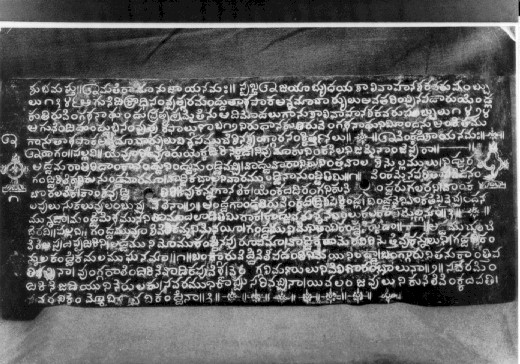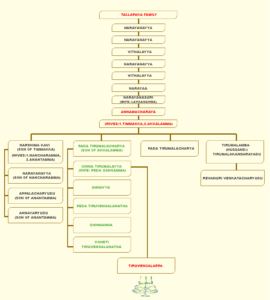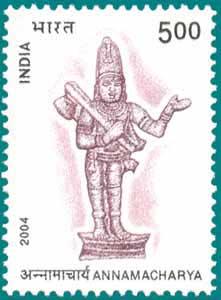Sri Tallapaka Annamacharya (Telugu: శ్రీ తాళ్ళపాక అన్నమాచార్య) (May 9, 1408 – February 23, 1503) also known as Annamayya (or) Annamacharyulu is saint composer of carnatic music.
Annamayya – Venkateswara’s bard Hailed as the ‘Pada Kavita Pitamaha’, for it was he who gave us the musical form of Pada, Annamacharya (1408-1503) was a forerunner of the great composers of Carnatic Music.
Born in a Brahmin family belonging to the Nandavarika community in Tallapaka village which is in Cuddapah district of present-day Andhra Pradesh, he felt the call of Lord Venkateswara of Tirumala very early in life. But it was at the age of 16 that he realised its true import and leaving his home he set out for the sacred hill. In nearby Ahobilam, he enrolled as a disciple of Shathakopa Yati (d 1458), a great scholar and studied the Vaishnavite philosophy. At the same time, he took to composing on the Lord of the Hill and His consort Alamelumanga. Over the years, while his compositions on the divine couple formed the largest part of his oeuvre, he also composed songs on a few other deities. His parents having found him after a long search convinced him of the need to return home. He was married to two women, Timmakka and Akkalamma. Leading the life of a householder, Annamacharya continued dedicating his life to singing the praise of Vishnu and over the years, an enormous corpus of songs emerged. He sang at least one song everyday on the deity, all of them structured with pallavi and charanas.
Interestingly, these do not pertain to philosophy alone. Out of a total of 32,000 songs that he is believed to have composed, 14,000 are available to us. The larger part of around 12000 songs comprises erotic themes depicting the love making of the divine couple Venkateswara and Alamelumanga. These are referred to as Sringara Sankirtanas. The remaining, classified as Adhyatmika Sankirtanas deal with devotion and higher philosophy. The devotional songs describe Alamelumanga, Venkateswara, temple rituals and services, social practices and folk customs.
Annamacharya was evidently an observer of life around him, though he looked at it only in relation to his deity Venkateswara. It would be no exaggeration to say that it is impossible to write about the various social mores, religious festivals, customs, practices and activities that Annamacharya managed to incorporate into his songs. In this he was clearly a forerunner of composers such as Purandara Dasa and Tyagaraja. Annamacharya’s music attracted the attention of the ruling king Saluva Narasimha of Penukonda. The mutual affection soon turned sour when the ruler desired that Annamacharya compose an erotic song on him. The composer refused and remained steadfast in his resolution of singing only in praise of Vishnu. The king saw the light and once again became devoted to the composer. Annamacharya composed twelve shatakas (sets of 100 verses) in praise of deities. He also created prabandas, wrote the Venkatachala Mahatmiya and composed the Ramayana in Telugu in dwipada metre. He also authored the Sangita Lakshanam, a treatise on music in Sanskrit. This is now lost, but its translation in Telugu by his grandson Chinna Tirumalacharya survives. Annmacharya’s was obviously a very creative family, for his first wife Timmakka composed a set of verses with Subhadra Kalyanam as its theme. Annamacharya’s son Pedda Tirumalacharya composed songs in the style of his father and wrote several works.
His son Chinna Tirumalacharya wrote Annamacharya’s biography. The family was evidently well-to-do for there are records of their having donated villages to the Tirumala and other temples for the daily conduct of several rituals. Annamacharya is credited with introducing the ceremonial bathing of Venkateswara every Friday, a practice that continues till date. The descendants of the family are honoured at the temple even today. During his lifetime, Annamacharya was well known. Chinna Tirumalacharya states that Purandara Dasa met Annmacharya and the similarities in the songs Saranu Saranu Surendra Vandita and Saranu Saranu Surendra Sevita, respectively by the two composers; both in Malavi Raga are offered as internal evidence. Annamacharya’s sons Narasinganna, Chinna Tiruvengalanatha and Pedda Tirumalacharya have been praised as poets and scholars by Tenali Ramakrishna, the scholar of Krishnadeva Raya’s court. The icons of Annmacharya and Pedda Tirumalacharya were carved on either side of the first gopuram of the Kalyana Venkateswara shrine in Srinivasa Manga Puram near Tirupati. This was done at the instance of Chinna Tirumalacharya who renovated the temple. An idol of Annamacharya also exists at this temple. This shrine also houses the idols worshipped by Annamacharya’s family. The songs of Annamacharya were originally on palm leaf manuscripts. Some of his palm leaf manuscripts are at the Tanjavur Saraswati Mahal Library. His son Pedda Tirumalacharya got them inscribed on copper plates between 1525 and 1545 and these were stored in a chamber called the Sankirtana Bhandaramu in the Tirumala premises. Later songs and works of other members of the Tallapaka family were also transferred to copper plates and added to this repository. This structure has the statues of Annamacharya and his son Pedda Tirumalacharya on either side. Over the years, the copper plates were forgotten and Annamacharya himself faded from memory. In 1816, AD Campbell, a Government officer first recorded the existence of these plates and sent a deputation to inspect them. On coming to know that they contained “nothing but voluminous hymns in praise of the Deity”, they were left as they were.
In 1904, Subbarama Diskhitar, writing his monumental Sangita Sampradaya Pradarsini recorded a brief narrative on ‘Tallapaka Chinnayya’ and credited him with being the founder of the Bhajana Paddhati. This must have been a reference to Chinna Tirumalacharya. It was only in 1922 that the temple authorities took steps to retrieve the copper plates and had them restored and coated with gold by the Madras Museum. Vetturi Prabhakara Sastry, the eminent Telugu scholar and a team working with him began the study of the songs in 1947. The first Vardhanti Festival of Annamcharya was celebrated by the Tirumala Tirupati Devasthanam (TTD) in 1949 and since then, all the available songs have been brought out in print in 32 volumes. The music of the songs as originally set by Annamacharya is lost. These are now sung to tunes set by musicians such as Rallapalli Ananthakrishna Sarma, M Balamuralikrishna and Nedunuri Krishnamurthy. That said, it must also be placed on record that it was MS Subbulakshmi’s rendition of them, released as a series of audio cassettes by the TTD that made the songs extremely popular. Today they are an integral part of Carnatic concert repertoire even as scholars continue studying and pondering over the lyrics. At times, one can only wonder at the ways of providence and the genius of Annamacharya
Compositions
- List of Annamacharya compositions beginning with A (Telugu: అన్నమయ్య సంకీర్తనలు [అ / ఆ ] జాబితా)
- List of Annamacharya compositions beginning with B (Telugu: అన్నమయ్య సంకీర్తనలు [ బ ] జాబితా)
- List of Annamacharya compositions beginning with C (Telugu: అన్నమయ్య సంకీర్తనలు [ చ / చా ] జాబితా)
- List of Annamacharya compositions beginning with D (Telugu: అన్నమయ్య సంకీర్తనలు [ద, డ] జాబితా)
- List of Annamacharya compositions beginning with E (Telugu: అన్నమయ్య సంకీర్తనలు [ ఇ, ఈ ] జాబితా)
- List of Annamacharya compositions beginning with G (Telugu: అన్నమయ్య సంకీర్తనలు [ గ ] జాబితా)
- List of Annamacharya compositions beginning with H (Telugu: అన్నమయ్య సంకీర్తనలు [ హ ] జాబితా)
- List of Annamacharya compositions beginning with I (Telugu: అన్నమయ్య సంకీర్తనలు [ ఇ ] జాబితా)
- List of Annamacharya compositions beginning with J (Telugu: అన్నమయ్య సంకీర్తనలు [ జ ] జాబితా)
- List of Annamacharya compositions beginning with K (Telugu: అన్నమయ్య సంకీర్తనలు [ క ] జాబితా)
- List of Annamacharya compositions beginning with L (Telugu: అన్నమయ్య సంకీర్తనలు [ ల ] జాబితా)
- List of Annamacharya compositions beginning with M (Telugu: అన్నమయ్య సంకీర్తనలు [ మ ] జాబితా)
- List of Annamacharya compositions beginning with N (Telugu: అన్నమయ్య సంకీర్తనలు [ న ] జాబితా)
- List of Annamacharya compositions beginning with O (Telugu: అన్నమయ్య సంకీర్తనలు [ ఒ ] జాబితా)
- List of Annamacharya compositions beginning with P (Telugu: అన్నమయ్య సంకీర్తనలు [ ప ] జాబితా)
- List of Annamacharya compositions beginning with R (Telugu: అన్నమయ్య సంకీర్తనలు [ ర ] జాబితా)
- List of Annamacharya compositions beginning with S (Telugu: అన్నమయ్య సంకీర్తనలు [ స ] జాబితా)
- List of Annamacharya compositions beginning with T (Telugu: అన్నమయ్య సంకీర్తనలు [ త , ట ] జాబితా)
- List of Annamacharya compositions beginning with U (Telugu: అన్నమయ్య సంకీర్తనలు [ ఉ , ఊ ] జాబితా)
- List of Annamacharya compositions beginning with V (Telugu: అన్నమయ్య సంకీర్తనలు [ వ ] జాబితా)
- List of Annamacharya compositions beginning with Y (Telugu: అన్నమయ్య సంకీర్తనలు [ య ] జాబితా)




Dear Sir,
Thank you once again for the excellent job done
I will also try to cooperate in further improving it to the best of my ability.
with best wishes
sistla somayajulu
Dear Sir
Excellent work!
One small correction Pl.
In title below the photo,Pl replace ‘Talapatra’ by ‘Tamrapatralu’ meanining copper sheet.
Thanq.
Dear Sir!
Thank you very much for the details given excellently.
It is a noble work. We remember you for ever.
Please provide swaramulu of atleast for popular keertanas so that we can sing in correct way n enjoy